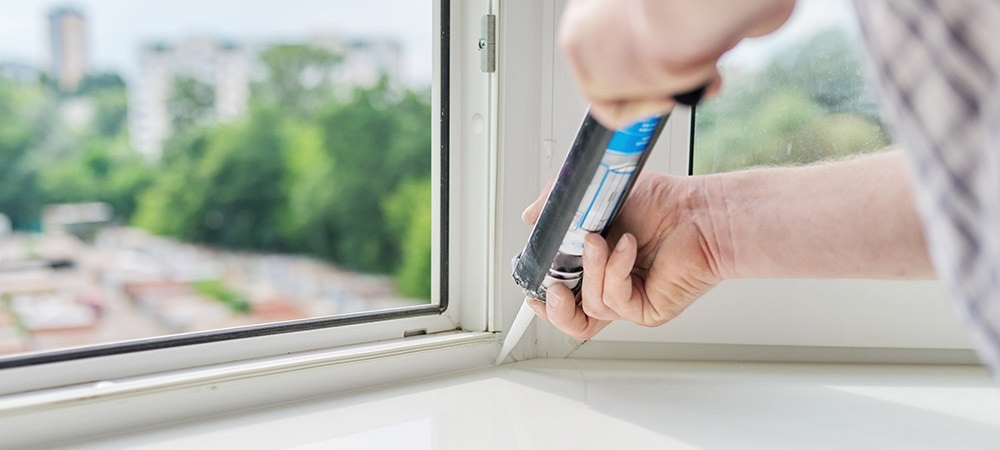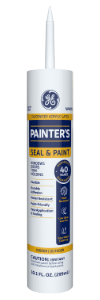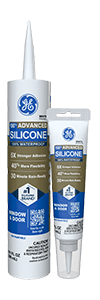Note: This DIY article is provided as a general guide only and is not intended to take the place of product-specific installation procedures; always follow applicable manufacturers’ instructions. Depending on your home’s age and condition, location within the home, and other potential factors, repairs and/or upgrades or other services may be necessary prior to the beginning and/or completion of your project that may involve the services of a home improvement professional. This article does not include advice pertaining to local building codes and/or any related inspections.
To ensure your next project is a success, you need to learn the differences between caulk vs. sealant. This guide shares what makes each product unique and when to use each one.
When tackling construction or renovation projects, selecting the right materials is essential for quality results. The last thing you want to do is compromise the success or longevity of your project. One common point of confusion is deciding between caulk vs. sealant. While caulk and sealant may seem similar, they serve different purposes based on their distinct technical properties.
This guide will clarify the differences between caulk vs. sealant, focusing on movement capabilities and ingredients so you can make an informed choice before diving into your next project.
What is caulk?
Caulk refers to a gunnable product designed to fill and seal joints where minimal movement is expected. It’s typically applied in areas where surfaces will remain relatively static, with a movement capability of less than 12.5%. This low movement threshold is intentional, as caulk is formulated for rigid, stable areas where flexibility is not a primary concern. Due to these characteristics, caulk is often used indoors in areas such as window frames, trim, and baseboards, where structural shifts or expansion are minimal.
Caulking specifically refers to the application of caulk to joints or seams. When you caulk something, you’re applying a carefully controlled layer of this product to ensure a tight seal against issues like minor drafts, moisture, or debris infiltration. Because of its precise and targeted application, caulk requires skilled handling to avoid gaps or unevenness, especially when it needs to blend seamlessly.
Ingredients and composition of caulk
One of the main differences between caulk vs. sealant is its ingredients. Caulk is typically made up of materials like acrylic or latex. These materials provide a smooth finish and make it easy to paint over, which is particularly useful in indoor applications where aesthetics is a priority. For example, an acrylic-latex caulk can be painted to match interior walls, trim, or moldings, enhancing the finished look of a project without sacrificing functionality.
Latex-based caulks also offer the benefit of easy cleanup, as they are water-soluble before curing. This feature makes them popular for interior use, where precision is important, and mistakes can be fixed quickly and with ease. However, caulk’s low tolerance for movement means it may crack or detach if used in areas with significant temperature fluctuations, high moisture exposure, or frequent material expansion. In these cases, you may need to reapply caulk later down the road.
Caulk is for static applications where there will be little movement. Sealant is for dynamic ones. Choose accordingly for long-lasting results and a successful project.
What is sealant?
Sealants are also gunnable solutions, and they are similar in function to caulks, but with a crucial distinction: movement capability. Unlike caulk, sealant is engineered for flexibility with a movement capability greater than 12.5%. This adaptability allows sealants to maintain a durable bond even as surfaces expand, contract, or shift over time. Sealants are crucial in areas exposed to fluctuating temperatures, weather conditions, or dynamic loads, which can cause materials to expand and contract.
Applying a sealant often refers to creating a flexible, water-resistant barrier capable of withstanding various environmental stressors. This is especially important in exterior applications, such as joints in concrete, glass facades, or siding, where moisture and temperature changes can weaken caulk.
Ingredients and composition of silicone
Silicone is the primary ingredient in most sealants due to its impressive flexibility, moisture resistance, and durability. Silicone-based sealants are ideal in environments exposed to water, such as bathrooms, kitchens, and outdoor settings. Unlike acrylic-latex caulk, silicone sealant does not crack or peel easily and can withstand UV exposure, making it perfect for outdoor use.
Additionally, silicone sealant adheres well to non-porous surfaces, such as glass and metal, allowing for a reliable bond in applications where surfaces may not readily accept other materials. This is what sets it apart from latex-based caulks, which may struggle to adhere to glass or aluminum without the use of additional bonding agents.
One tradeoff with silicone sealants, however, is the inability to paint them. While they provide exceptional durability, they often retain a slightly shiny finish that may not blend with certain aesthetics. For interior uses where a painted finish is desired, specialized silicone formulations or hybrid sealants may be available, but standard silicone will not bond well with paint.
Technical terminology you need to know
To truly understand the nuances between silicone sealant vs. caulk, it helps to dive into the specific terminology and ingredients that define their performance. Knowing this information can guide you in selecting products tailored to the unique demands of each project. Here are some essentials to keep in mind:
- Skinning and curing times: Both caulk and sealant have different skinning (initial drying) and curing (fully drying) times. Sealants, especially silicone-based ones, generally form a skin quickly, allowing work in high-moisture areas, though they may take longer to fully cure. Caulks tend to cure faster but can be vulnerable to moisture if applied before drying.
- Joint movement capability: Caulk and sealant products are often rated by their joint movement capability, expressed as a percentage. This rating indicates how much a product can expand and contract without cracking. Caulks are typically rated for low movement (less than 12.5%), while sealants are designed for greater flexibility, adapting to shifting materials.
- Plasticizers: Commonly found in caulks, plasticizers add flexibility to the product but can lead to off-gassing and sometimes degrade over time, which is why caulks often need replacement sooner than silicone-based sealants. High-quality caulks may use advanced plasticizers to extend longevity, so they don’t need to be redone as quickly.
- UV stabilizers and mildewcides: Often added to silicone sealants, UV stabilizers protect against yellowing and cracking caused by sunlight exposure. Mildewcides prevent mold and mildew growth, making silicone sealants suitable for bathrooms, kitchens, and outdoor applications.
- Types of silicone sealants: Acid-cure sealants release acetic acid during curing, which can produce a vinegar-like smell. It’s highly adhesive but can corrode sensitive materials. Neutral-cure sealants release non-corrosive byproducts, making them ideal for materials that may react with acids. They’re also preferred for exterior applications or around metals.
It’s also worth keeping in mind that the American Society for Testing and Materials, as well as the International Organization for Standardization, provide technical standards for caulks and sealants. Look for these certifications when purchasing to ensure an additional level of quality assurance.
When to use caulk vs. sealant
In most cases, caulk is the right choice for indoor projects where a low-movement, paintable surface is essential. This includes tasks like finishing trim, baseboards, and window frames. Caulk’s ease of cleanup and compatibility with paint make it versatile for such controlled applications.
Sealant is the preferred option for outdoor or high-movement areas where flexibility is essential. It’s also a must in moisture-prone areas due to sealant being mold and mildew-resistant. Applications such as sealing around sinks, bathtubs, exterior siding, and joints in masonry are best suited for sealants due to their resilience against movement and environmental factors like moisture. When in doubt, opt for sealant in environments where durability and flexibility are essential. Keeping these tips in mind will ensure it’s easy to decide which one is better for your project.
Whether you’re looking for a durable silicone sealant for exterior use or a smooth, paintable caulk for interior detailing, our lineup has you covered. Explore our range of high-performance products and discover the perfect solution for your next project. For more information, visit our Where to Buy page to find our products at a location near you.



